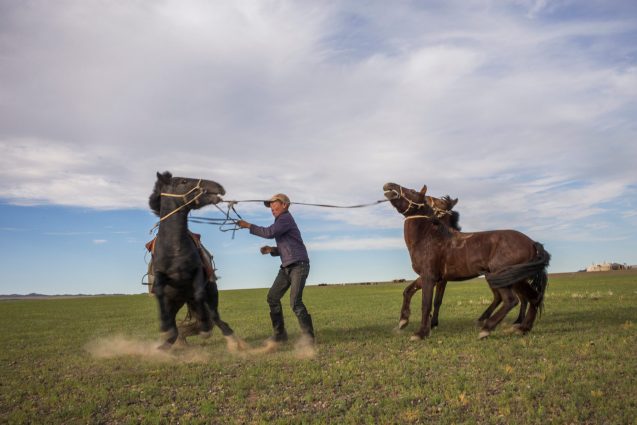
Mongolia is like a second home to Zellner: he has already travelled over half a dozen times to the barren region, in order to spend time with the nomadic people there, and explore their daily lives; and he is never without his film and photography equipment close at hand. In addition to internationally distributed and award-winning documentaries, his journeys have resulted in numerous unique images.
What is daily life like for the nomads?
Daily life for the nomads can be very diverse, and it’s not easy to generalise; however, they do all share a life connected with nature, and must survive under extreme climatic conditions. Something like crop farming is not possible in the Mongolian deserts and steppes. The nomads have to move on regularly with their herds, so that the animals don’t destroy the vegetation completely. In this sense, the nomads live constantly on the edge of an ecological catastrophe, and they need extensive areas, so as not to leave lasting damage behind them when they move on. Goats which, in addition to meat, supply valuable Kashmir wool, can cause serious destruction, because they eat plants with the whole root. That’s why the nomads always try to keep a mixed herd, with a large portion of sheep. Furthermore, they normally keep horses and often camels, cattle or yaks. In addition to wool, they make use of the milk and the meat, predominantly as supplies for themselves. Because of their lifestyle, nomads are extremely dependent on the climate – even small changes can lead to catastrophes that force them to give up their way of life. In recent years, the severe droughts, strong rains and extreme winters have been very hard on the nomads in Mongolia.
How did your protagonists react to you as a photographer?
The people are always very hearty and welcoming; they happily share their food and sleeping places. They are very humble and reticent, and it’s important to behave in the same way – to not take advantage of the situation, and to never be stingy. Sharing and being ready to help is the order of the day – and it’s important not to impose. I, myself, tend to be shy, and I don’t want to simply photograph people any old way. I prefer to wait quietly and, after some time, I begin to take pictures; but I try not to push it too much up front.
Were there great language or cultural hurdles to overcome?
I’ve known about Mongolian culture for a long time. When I was a student at film school I was in Mongolia a number of times with director Batmunkh Sukhbaatar. I travelled there a lot, and spent much of my time with Mongols who don’t speak any foreign languages. In the meantime, I understand the language to a small degree, and I’ve been collaborating with the Mongolian/German director Uisenma Borchu for a number of years.
What were the biggest challenges from the photographic perspective?
The photos we’re talking about right now were taken during a trip when we began doing research for our feature film Schwarze Milch (Black Milk). Consequently, the pictures were taken somewhat on the side. The biggest challenge in this respect was taking photographs of illegal gold digs in the Gobi, of coal miners in Nalaikh — the most dangerous coal mine in the world – and in Denjiin Myanga.
How long, in total, have you spent in this part of the world? What did you personally bring away from these journeys?
Unless I’ve miscounted, it’s been a total of eight journeys since 2004. The encounters with all kinds of very different people in Mongolia were very enriching. The desert, the quiet, the seemingly endless expanses; as well as the nomad’s serenity, patience, humility and warmth – all move me and oblige me to question myself more deeply. That’s something that I, as a person who grew up in the West, should adopt for myself.
Which camera did you use, and how well did it serve you in realising your aims?
I use a Leica M, and always with a Leica Summicron-M 35 f/2 ASPH. Focussing with a rangefinder is quick and precise. At the same time, the Leica M is small, light and discreet – a very decisive advantage, if you don’t want to push yourself forward when taking photographs.
What projects can we be looking forward to next?
As a photographer, I’m currently looking out for new documentary themes – in Mongolia again, among other places. At the moment, it’s difficult to say what will come next… I really hope that the next thing we’ll do is make a feature film in Mongolia – though that’s still in the stars.
Sven Zellner studied Image Composition and Cinematography at the HFF Munich, and published his first photo book when he was 22 years old. He was the Director of Photography for films such as Walchensee Forever, directed by Janna Ji Wonders; as well as Schwarze Milch (Black Milk) and Schau mich nicht so an (Don’t look at me that way), directed by Uisenma Borchu. He had his directorial documentary film debut with Preis des Goldes (Price of Gold). His photos have appeared in the likes of GEO, DIE ZEIT, Das Magazin and Terra Mater. You can discover more about his photography on his website and Instagram account.
Leica M
The Leica. Yesterday. Today. Tomorrow.




















